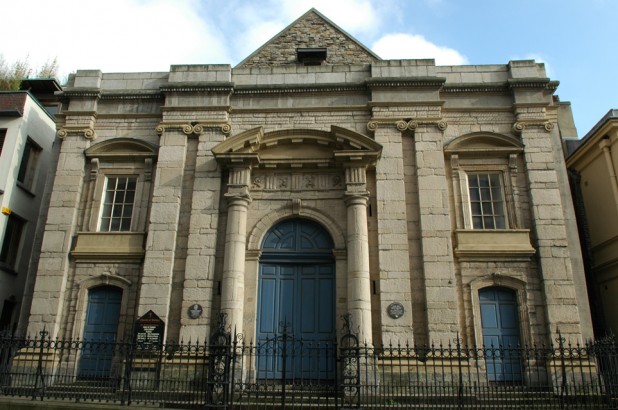
Werburgh Street derived its name from a church erected there after the Anglo – Norman settlement, which was dedicated to Saint Werburgh, patron of Chester. St. Werburgh’s is mentioned in a Papal letter of 1179 and, on the night of Saint Colum’s festival in 1311, a great part of the city of Dublin was burned down and St. Werburgh’s Church also perished in this fire. In 1630, a new St Werburgh’s church had a parish consisted of 239 householders, 28 Catholics and the remainder Protestants.
James Southwell, bachelor, was born in the Parish of St. Werburgh and died in 1729 aged eighty eight years old. He bequeathed the sum of twelve hundred and fifty pounds to the church to be divided and used as follows:
- · Service of a lecturer to read prayers and preach a sermon every second Wednesday the sum of twenty pounds.
- · Supply of bread for the poor after each sermon the sum of three shillings and four pence.
- · Supply of candles on dark nights at lecture the sum of one pound.
- · Supply of coals for poor room keepers the sum of four pounds, three shillings, and four pence.
- · To apprentice a parish boy to a trade the sum of three pounds.
- · Supply of a clock the sum of forty five pounds.
- · For the ringing of bells the sum of three hundred and eighty six pounds.
- · Donation to poor widows the sum of twenty pounds.
In June 1798, the corpse of Lord Edward Fitzgerald was brought from Newgate and entombed in the vaults of St. Werburgh’s. According to Lord Henry Fitzgerald, brother of Edward, a guard was to be provided to escort the remains from Newgate, through the streets, to St. Werburgh’s. It never arrived and the burial did not take place until near 2 o’clock in the morning. Ironically, the remains of Henry Charles Sirr, the captor of Lord Edward Fitzgerald, were buried in 1841, in the eastern side of this cemetery.
At the southern end of Werburgh Street, one of the city portals, known as St. Werburgh’s gate or the “Pole Gate” was situated. In 1171, Richard de Cogan issued an attack against the Norsemen, who had besieged the city, through this gate.
The first playhouse recorded to have been established in Dublin, was a little theatre opened in Werburgh Street by John Ogilby, who came to Ireland in 1633, with Lord Deputy Wentworth. An Act of Parliament passed in Dublin in 1636, denounced all actors and show business people as rogues and villains. The Werburgh Street theatre continued until 1641, when it was closed by order of the Lords Justices, because of the disturbed state of the country.
In the 17th century, the Main Guard of the city was located at the southern end of St. Werburgh’s. A court martial held at this time stated that two soldiers who had stolen five shillings in money and eight shillings worth of goods, in a violent theft were sentenced to be “whipt from the Main Guard to ye Gallows and backward againe to ye guard, each of them to receive forty lashes and were being first dismounted and reduced as foote soldiers.”The station of the Main Guard was afterwards used as a watch – house but its original use was denoted by the name “Gun Alley” situated nearby. This alley was later demolished and schools were erected on the site.
A passage from St. Werburgh’s Street to St. Nicholas Street was known, at the end of the 12th century, as the Shoemaker’s Street, it was also called St. Werburgh’s. This lane was built over about 1580 and the prison of the Four Courts Marshalsea was erected at St. Werburgh’s Street entrance.
On the western side of St. Werburgh Street stood Darby Square, a piece of ground about eighty feet in length and surrounded by twelve houses. Samuel Dalton’s shop was at the entrance from Werburgh Street. He was a bookseller and publisher from 1730 to 1741. In 1785, a portion of the pavement collapsed suddenly, revealing a cave forty feet deep, containing a large quantity of coffins and bones, probably from the old cemetery of St. Martin’s Church. There was a green adjoining Darby Square and during the troubles of 1798, a yeomanry corps of about two hundred men, principally from the Liberties, and known as the Liberty Rangers, marched to this green on Sundays to perform their military practice. This group performed a lot of the outpost duty during 1798 and, as a result of their position, received plenty of abuse in Weaver’s Hall, on the Coombes, which was their headquarters.








